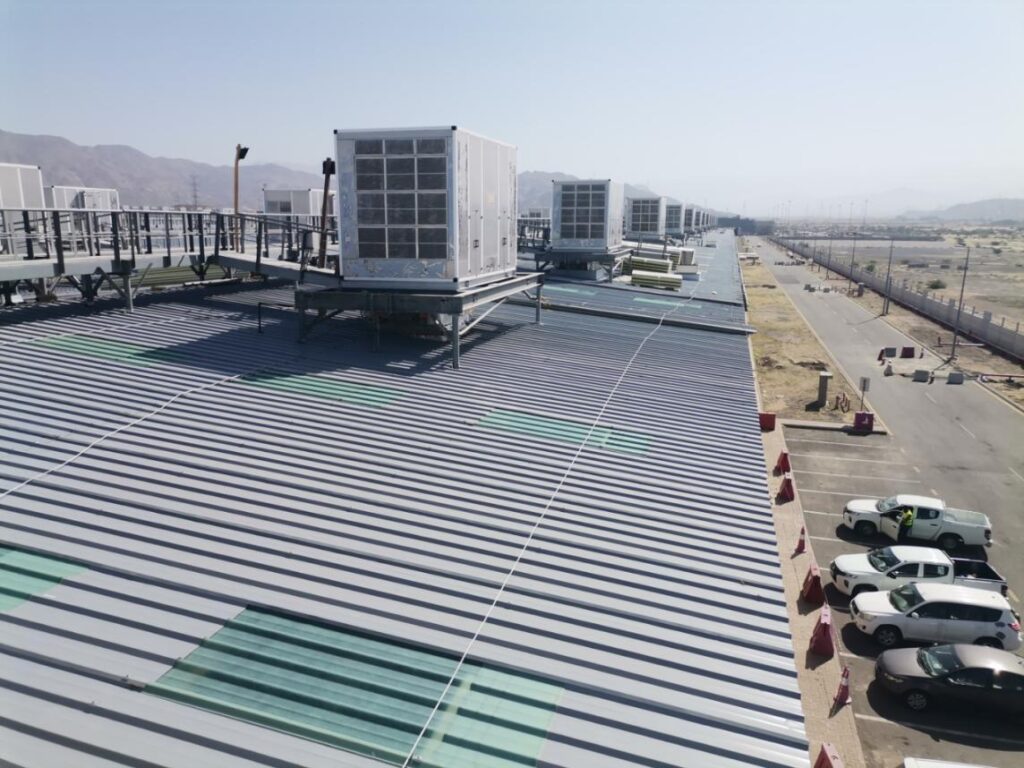- 00966548586837
- info@spanel-group.com
- Aziziyah, Jeddah, Saudi Arabia
All types of work – from designing and laying the Foundation finishing and commissioning. Tight deadlines, reasonable.
All types of work – from designing and laying the Foundation finishing and commissioning. Tight deadlines, reasonable.
All types of work – from designing and laying the Foundation finishing and commissioning. Tight deadlines, reasonable.

Discover the comprehensive range of services offered by Spanel to meet your roofing and cladding requirements. We provide tailored solutions that enhance functionality and aesthetics while ensuring top-quality results.

Providing top-grade roofing and cladding materials and products for your projects.

Expert installation services for seamless and durable roofing and cladding systems.

Comprehensive solutions for new roof installations, repairs, and maintenance.

Specialized installation of cold stores, ensuring optimal preservation and efficiency.

Effective waterproofing solutions to protect your structures from moisture and leaks.

Professional repair and maintenance services to extend the lifespan and performance of your roofing and cladding.
Extensive industry knowledge and expertise to handle diverse projects.
Ensuring the highest standards of quality and safety in every aspect.
Customized approaches to meet unique project requirements and specifications
Efficient project management to complete projects on schedule.
Focus on exceeding client expectations and building long-lasting relationships.
Offering cost-effective solutions without compromising on quality.
Our engineers conduct a thorough site visit to assess your project requirements and understand your specific needs.
We create a detailed project plan, considering design, materials, and timelines, to ensure a seamless execution.
Our skilled team procures top-grade materials and carries out the installation with precision, adhering to industry standards.
Precious ipsum dolor sit amet consectetur adipisicing elit, sed dos mod tempor incididunt ut labore et dolore magna aliqua. Ut enim ad min veniam, quis nostrud Precious ips um dolor sit amet, consecte

Precious ipsum dolor sit amet consectetur adipisicing elit, sed dos mod tempor incididunt ut labore et dolore magna aliqua. Ut enim ad min veniam, quis nostrud Precious ips um dolor sit amet, consecte

Precious ipsum dolor sit amet consectetur adipisicing elit, sed dos mod tempor incididunt ut labore et dolore magna aliqua. Ut enim ad min veniam, quis nostrud Precious ips um dolor sit amet, consecte

Precious ipsum dolor sit amet consectetur adipisicing elit, sed dos mod tempor incididunt ut labore et dolore magna aliqua. Ut enim ad min veniam, quis nostrud Precious ips um dolor sit amet, consecte
























Introduction to Gable Trims Gable trims are an essential component in roofing systems, providing both functional and aesthetic benefits to buildings, Installed along the edges of the gable roofs, these trims protect the roof and underlying structures from the elements while also adding a polished, finished look to the building’s exterior. Gable trims are crucial in preventing water infiltration, shielding roof edges from wind damage, and contributing to the overall architectural appeal. This article will explore the importance of gable trims, the materials used, installation techniques, and their role in both residential and commercial construction projects. Importance of Gable Trims in Roofing Systems Gable trims serve a dual purpose in roofing systems: they offer protection and enhance the appearance of a building. By covering the vulnerable edges of the roof, gable trims prevent damage that could lead to costly repairs and maintain the structural integrity of the roof over time. Protection Against Water Infiltration: One of the primary functions of gable trims is to prevent water from seeping into the roof and walls. Water infiltration can cause significant damage, including rot, mold, and structural weakening. Gable trims are designed to direct water away from the roof edges and into the gutters, reducing the risk of water-related issues. Wind Damage Prevention: Roof edges are particularly susceptible to wind damage, especially during storms or high winds. Gable trims provide an added layer of protection by securing the roof edges and preventing wind uplift. This is especially important in regions prone to severe weather, where wind can easily lift and damage unprotected roof materials. Enhanced Aesthetic Appeal: Beyond their protective functions, gable trims play a significant role in the aesthetic appeal of a building. They create a clean, finished edge along the roofline, contributing to a cohesive and visually pleasing design. Gable trims are available in various styles, colors, and materials, allowing builders and homeowners to choose options that complement the overall design of the building. Increased Longevity of Roofing Materials: By protecting the edges of the roofing materials from the elements, gable trims help extend the lifespan of the roof. Without trims, roofing materials at the edges can become worn and damaged more quickly, leading to the need for repairs or replacement sooner than expected. Gable trims, therefore, play a crucial role in maintaining the durability and longevity of the roof. Materials Used in Gable Trims Gable trims are manufactured from a variety of materials, each offering different benefits in terms of durability, appearance, and cost. The choice of material depends on factors such as the building’s location, climate, and design preferences. Installation Techniques for Gable Trims Proper installation of gable trims is essential to ensure they provide the intended protection and aesthetic enhancement. The installation process varies depending on the material and the specific roof design, but general steps include: Conclusion Gable trims are a critical element in roofing systems, providing essential protection against water infiltration, wind damage, and other environmental factors. They also enhance the aesthetic appeal of buildings, contributing to a polished and cohesive exterior design. By choosing the right materials and ensuring proper installation, gable trims can significantly extend the lifespan of a roof and maintain the structural integrity of the building. Whether for residential or commercial construction, investing in high-quality gable trims is a wise decision that offers long-term benefits in both protection and appearance. #Gable_trims_installation #aluminum_gable_trims #galvanized_steel_roof_trims #roofing_edge_protection #gable_trim_benefits #vinyl_gable_trims #copper_roof_edge_trims #architectural_roof_detailing.
Introduction to Pipe Dektite Pipe Dektite is an innovative roofing accessory used to create watertight seals around pipes that penetrate roofs or walls. These flashing boots are essential in preventing leaks, providing a flexible and secure seal for various pipe materials, including metal, PVC, or rubber. Typically made from high-quality EPDM or silicone, Pipe Dektite products are renowned for their durability, weather resistance, and easy installation. Their importance in ensuring long-term protection for roofing systems cannot be understated. What is Pipe Dektite? Pipe Dektite is a form of pipe flashing designed to maintain the integrity of roofing structures where pipes and ducts pass through. It features a flexible boot or cone that can accommodate different pipe diameters. The base of the Pipe Dektite, typically made from flexible metal or rubber, allows it to conform to the roofing surface, ensuring a tight, watertight seal. The primary benefit of Pipe Dektite is its adaptability. Whether you’re working on a sloped or flat roof, the flexible base can easily shape itself to the roofing material. Moreover, the conical design enables easy trimming, making it suitable for different pipe sizes. Pipe Dektite flashings are available in various models, designed to withstand specific environmental conditions such as extreme temperatures, UV exposure, and corrosive chemicals. Types of Pipe Dektite Applications of Pipe Dektite Benefits of Using Pipe Dektite How to Install Pipe Dektite Conclusion Pipe Dektite is a crucial element in preserving the integrity of roofing systems, especially in areas with pipe penetrations and other openings, Known for its flexibility, strength, and simple installation, it offers a dependable solution for both residential and commercial roofs, Whether facing harsh weather conditions, temperature shifts, or intricate roof designs.
Introduction to Regret Flashing “Regret flashing” is a crucial element in roofing systems, primarily used to seal and safeguard areas where the roof meets vertical surfaces such as walls, chimneys, or parapets, Although the term “regret flashing” is not widely recognized within the industry, it generally refers to more standard types of flashing, such as step flashing or counter flashing, Understanding the purpose, materials, and proper installation techniques of these flashing methods is essential for ensuring long term protection against water intrusion. In this context, regret flashing refers to the protective barriers installed to prevent water infiltration, one of the most common issues in roofing that can lead to costly repairs if not addressed correctly. This article delves into the specifics of regret flashing, its applications, and the best practices for installation to ensure a watertight and durable roofing system. What is Regret Flashing? Regret flashing, often synonymous with step flashing or counter flashing, is installed in areas where roofing materials meet vertical surfaces such as walls, chimneys, or skylights. These intersections are vulnerable to water infiltration, as rainwater naturally flows towards these joints. Without proper flashing, water can seep into the building structure, leading to leaks, mold, rot, and significant damage. Types of Regret Flashing: Importance of Regret Flashing: Regret flashing is crucial for several reasons: Materials Used in Regret Flashing The effectiveness of regret flashing largely depends on the materials used. Various materials are available, each offering distinct advantages depending on the specific requirements of the roofing project. Installation Techniques for Regret Flashing Proper installation of regret flashing is essential to ensure that it performs its intended function of protecting the building from water infiltration. The installation process varies depending on the type of flashing and the specific application, but general steps include: Conclusion Regret flashing, whether in the form of step, counter, or base flashing, is an indispensable element in protecting a building’s roof and walls from water infiltration. By choosing the right materials and ensuring proper installation, builders and homeowners can prevent leaks, prolong the life of the roofing system, and maintain the overall integrity of the structure. Understanding the importance of regret flashing and implementing best practices in its application are crucial steps in any roofing project, ensuring long-term performance and peace of mind. #Regret_flashing_installation #step_flashing #counter_flashing #roof_waterproofing #aluminum_flashing #galvanized_steel_flashing #copper_roof_flashing #lead_flashing #roofing_materials #roof_leak_prevention
Copyright © 2025 Spanel Group. All Rights Reserved. Powered by The Mixers